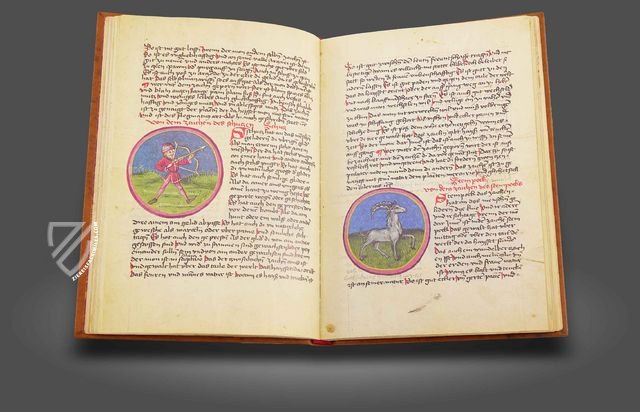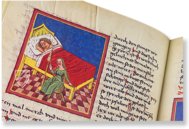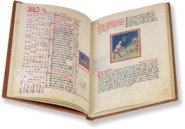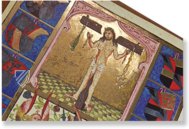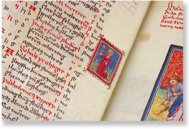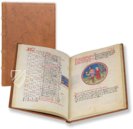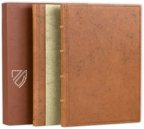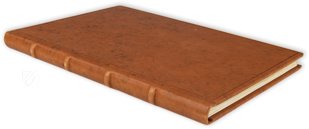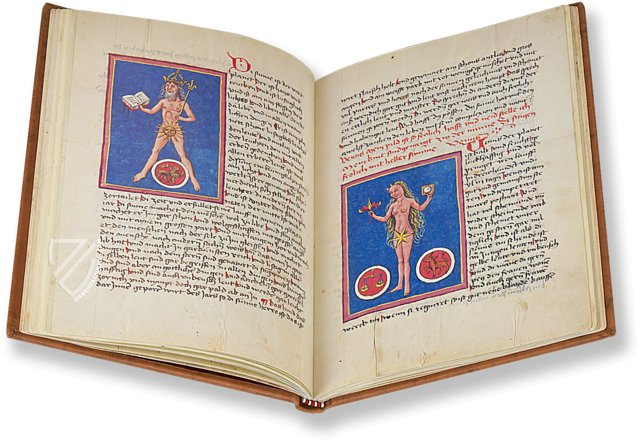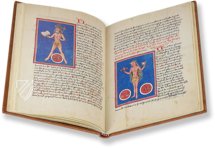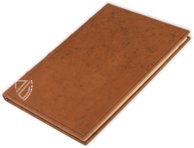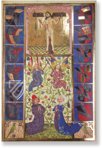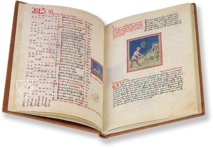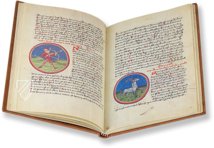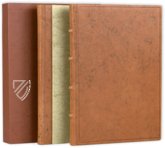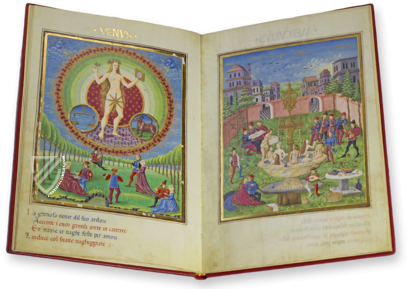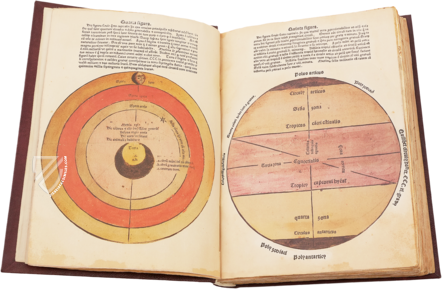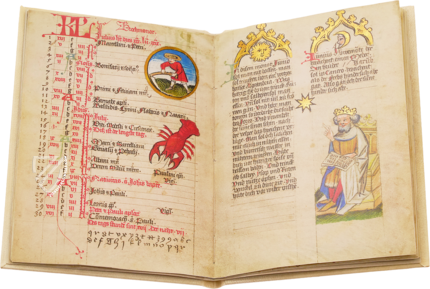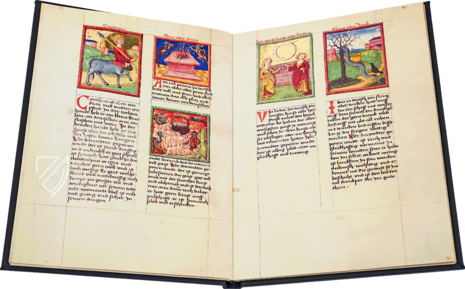Codex Schürstab
(under 1,000€)
The Codex Schürstab is a medieval astrological handboook that explains the lessons of the planets and stars in connection with their influence on human life and health. The text is written in Old German and is therefore addressed to less educated lay people, although the lavish and precious decoration of the manuscript is more than worthy of its wealthy patrons: The couple Erasmus and Dorothea Schürstab belonged to an influential patrician family in Nuremberg. This is reflected in the 54 refined and extremely high-quality miniatures, which not only vividly depict planetary movements and signs of the zodiac with great variety, but also expressively illustrate the practical advices for the treatment of different diseases. For this, the talented but unknown master used the finest painting materials as well as the most delicate gold leaf.
Codex Schürstab
The handbook of medicine in the Middle Ages, the most famous edition of which is the Codex Schürstab, originates from 15th century Nuremberg and sheds light on the various rules of health that are recorded here in old German layman’s language. In the Middles Ages, the dominant teachings of the four elements and especially the influence of the planets on the Earth and people that was taught at universities were made accessible to less-educated people on the 124 pages of this work, which is decorated with a total of 54 impressive miniatures.
The Medical Guidebook of the Middle Ages
Of the Influence of the Stars encapsulates the astrological phenomena, of which people in the Middle Ages attributed great importance. The planets influenced not only the weather and years, but also had a direct influence on the lifespan of a person, on the progression of diseases, and the treatment of such illnesses. There were specific times recommended, in which bloodletting would be best conducted, when laxatives should be taken or even when it would be better to leave it alone. The work gives the modern reader a comprehensive depiction of the medieval worldview.
Medieval Astronomy and Hygienics
The work opens with tables that serve as a basis for the calculation of the lunar phases and feast days. Following thereafter is a calendar with rules for the months and twelve chapters, which are dedicated to the explanation of the zodiac in great detail and with appealing miniatures. These are accompanied with seven-part groups of text, which are characterized by a spherical depiction of the stars and planets and comprise a comprehensive planetary lesson. The next part of the book describes the doctrine of humors that had already been practiced since antiquity. In clear, impressive miniatures, the properties and behaviors were thematized, which were linked to the four different humors of the body (choleric, phlegmatic, sanguine, and melancholic). The last group of themes in the work are concerned with medical aspects such as blood-letting, blood-testing, bathing, and cupping. Finally one finds a few prescriptions that were useful for good health.
Astute Illustrations
An unknown artist is responsible for the 54 miniatures of preeminent quality. In the highest technical refinement and applying the finest paints, he illustrated the pages of the work. He is guided by traditional picture motifs of medieval book painting, but mates every illustration with his own personal touch. This allows him to combine Gothic Realism with the cheerful style of late medieval bourgeoisie. Through the use of the finest colors and shimmering gold leaf the paintings were made into a small but valuable work of art.
Codicology
- Alternative Titles
- On the Influence of the Stars
Vom Einfluß der Gestirne
Altteutscher astro-medicinischer Rathgeber - Size / Format
- 124 pages / 29.5 × 20.7 cm
- Origin
- Germany
- Date
- Ca. 1472
- Epochs
- Style
- Genre
- Language
- Illustrations
- 54 miniatures carried out using the most noble pigments and shimmering gold leaf
- Patron
- Erasmus und Dorothea Schürstab
- Previous Owners
- Johann Jakob Zoller
Codex Schürstab
Zodiac Man
The so-called “Zodiac Man” was common in medieval calendars, books of hours, and treatises on philosophy, astrology, and medicine. Rooted in ancient medicine going back to the Babylonians, medieval physicians believed that there was a connection between the cosmos (macrocosm) and the human body (microcosm). Furthermore, they associated particular body parts with zodiac signs and planned procedures based upon the cosmos, especially the moon, whose effects on the tides are self-evident.

Codex Schürstab
Donor Portrait
This medical/cosmological manuscript opens with a depiction of the patrons of this remarkable work: the famous Erasmus and Dorothea Schürstab from Nuremburg. They are pictured in prayer on grass before a background of tendrils and flowers. Both hold rosary beads, are dressed in the fashion of late-medieval urban bourgeoisie, and flanked by twelve escutcheons.
Christ appears battered and displaying his wounds at the top of the page before a brilliantly polished, patterned gold background. He is framed by a Gothic doorway and standing on a checkboard floor. A palm branch hangs from the left arm of the cross and a scourge from the right, symbolizing the Passion. Floating beneath him are two angels bearing the spear and vinegar-soaked sponge of the Crucifixion.

#1 Vom Einfluß der Gestirne
Language: German
(under 1,000€)
- Treatises / Secular Books
- Apocalypses / Beatus
- Astronomy / Astrology
- Bestiaries
- Bibles / Gospels
- Chronicles / History / Law
- Geography / Maps
- Saints' Lives
- Islam / Oriental
- Judaism / Hebrew
- Single Leaf Collections
- Leonardo da Vinci
- Literature / Poetry
- Liturgical Manuscripts
- Medicine / Botany / Alchemy
- Music
- Mythology / Prophecies
- Psalters
- Other Religious Books
- Games / Hunting
- Private Devotion Books
- Other Genres
- Afghanistan
- Armenia
- Austria
- Belgium
- Colombia
- Croatia
- Cyprus
- Czech Republic
- Denmark
- Egypt
- Ethiopia
- France
- Germany
- Greece
- Hungary
- India
- Iran
- Iraq
- Israel
- Italy
- Japan
- Lebanon
- Luxembourg
- Mexico
- Morocco
- Netherlands
- Palestine
- Peru
- Poland
- Portugal
- Russia
- Serbia
- Spain
- Sri Lanka
- Sweden
- Switzerland
- Syria
- Turkey
- Ukraine
- United Kingdom
- United States
- Uzbekistan
- Aboca Museum
- Ajuntament de Valencia
- Akademie Verlag
- Akademische Druck- u. Verlagsanstalt (ADEVA)
- Aldo Ausilio Editore - Bottega d’Erasmo
- Alecto Historical Editions
- Alkuin Verlag
- Almqvist & Wiksell
- Amilcare Pizzi
- Andreas & Andreas Verlagsbuchhandlung
- Archa 90
- Archiv Verlag
- Archivi Edizioni
- Arnold Verlag
- ARS
- Ars Magna
- ArtCodex
- AyN Ediciones
- Azimuth Editions
- Badenia Verlag
- Bärenreiter-Verlag
- Belser Verlag
- Belser Verlag / WK Wertkontor
- Benziger Verlag
- Bernardinum Wydawnictwo
- BiblioGemma
- Biblioteca Apostolica Vaticana (Vaticanstadt, Vaticanstadt)
- Bibliotheca Palatina Faksimile Verlag
- Bibliotheca Rara
- Boydell & Brewer
- Bramante Edizioni
- Bredius Genootschap
- Brepols Publishers
- British Library
- C. Weckesser
- Caixa Catalunya
- Canesi
- CAPSA, Ars Scriptoria
- Caratzas Brothers, Publishers
- Carus Verlag
- Casamassima Libri
- Chavane Verlag
- Christian Brandstätter Verlag
- Circulo Cientifico
- Club Bibliófilo Versol
- Club du Livre
- CM Editores
- Collegium Graphicum
- Collezione Apocrifa Da Vinci
- Comissão Nacional para as Comemorações dos Descobrimentos Portugueses
- Coron Verlag
- Corvina
- CTHS
- D. S. Brewer
- Damon
- De Agostini/UTET
- De Nederlandsche Boekhandel
- De Schutter
- Deuschle & Stemmle
- Deutscher Verlag für Kunstwissenschaft
- DIAMM
- Droz
- E. Schreiber Graphische Kunstanstalten
- Ediciones Boreal
- Ediciones Grial
- Ediclube
- Edições Inapa
- Edilan
- Editalia
- Edition Deuschle
- Edition Georg Popp
- Edition Leipzig
- Edition Libri Illustri
- Editiones Reales Sitios S. L.
- Éditions de l'Oiseau Lyre
- Editions Medicina Rara
- Editorial Casariego
- Editorial Mintzoa
- Editrice Antenore
- Editrice Velar
- Edizioni Edison
- Egeria, S.L.
- Eikon Editores
- Electa
- Emery Walker Limited
- Enciclopèdia Catalana
- Eos-Verlag
- Ephesus Publishing
- Ernst Battenberg
- Eugrammia Press
- Extraordinary Editions
- Fackelverlag
- Facsimila Art & Edition
- Facsimile Editions Ltd.
- Facsimilia Art & Edition Ebert KG
- Faksimile Verlag
- Feuermann Verlag
- Folger Shakespeare Library
- Franco Cosimo Panini Editore
- Friedrich Wittig Verlag
- Fundación Hullera Vasco-Leonesa
- G. Braziller
- Gabriele Mazzotta Editore
- Gebr. Mann Verlag
- Gesellschaft für graphische Industrie
- Getty Research Institute
- Giovanni Domenico de Rossi
- Giunti Editore
- Graffiti
- Grafica European Center of Fine Arts
- Guido Pressler
- Guillermo Blazquez
- Gustav Kiepenheuer
- H. N. Abrams
- Harrassowitz
- Helikon
- Hendrickson Publishers
- Henning Oppermann
- Herder Verlag
- Hes & De Graaf Publishers
- Hoepli
- Holbein-Verlag
- Hortus Deliciarum
- Houghton Library
- Hugo Schmidt Verlag
- Idion Verlag
- Il Bulino, edizioni d'arte
- ILte
- Imago
- Insel Verlag
- Instituto Nacional de Antropología e Historia
- Istituto dell'Enciclopedia Italiana - Treccani
- Istituto Ellenico di Studi Bizantini e Postbizantini
- Istituto Geografico De Agostini
- Istituto Poligrafico e Zecca dello Stato
- Italarte Art Establishments
- J. Thorbecke
- Jan Thorbecke Verlag
- Johnson Reprint Corporation
- Josef Stocker
- Josef Stocker-Schmid
- Jugoslavija
- Karl W. Hiersemann
- Kasper Straube
- Kaydeda Ediciones
- Kindler Verlag / Coron Verlag
- Kodansha International Ltd.
- Konrad Kölbl Verlag
- Kurt Wolff Verlag
- La Liberia dello Stato
- La Linea Editrice
- La Meta Editore
- Lambert Schneider
- Landeskreditbank Baden-Württemberg
- Leo S. Olschki
- Les Incunables
- Library of Congress
- Libreria Musicale Italiana
- Lichtdruck
- Lito Immagine Editore
- Lumen Artis
- Lund Humphries
- M. Moleiro Editor
- Maison des Sciences de l'homme et de la société de Poitiers
- Manuscriptum
- Martinus Nijhoff
- Maruzen-Yushodo Co. Ltd.
- MASA
- McGraw-Hill
- Militos
- Millennium Liber
- Müller & Schindler
- Nahar and Steimatzky
- National Library of Wales
- Neri Pozza
- Nova Charta
- Oceanum Verlag
- Odeon
- Orbis Mediaevalis
- Orbis Pictus
- Österreichische Staatsdruckerei
- Oxford University Press
- Pageant Books
- Parzellers Buchverlag
- Patrimonio Ediciones
- Pattloch Verlag
- PIAF
- Pieper Verlag
- Plon-Nourrit et cie
- Prestel Verlag
- Princeton University Press
- Prisma Verlag
- Priuli & Verlucca, editori
- Pro Sport Verlag
- Propyläen Verlag
- Pytheas Books
- Quaternio Verlag Luzern
- Reales Sitios
- Recht-Verlag
- Reichert Verlag
- Reichsdruckerei
- Riehn & Reusch
- Roberto Vattori Editore
- Rosenkilde and Bagger
- Roxburghe Club
- Salerno Editrice
- Sarajevo Svjetlost
- Schöck ArtPrint Kft.
- Scolar Press
- Scrinium
- Scripta Maneant
- Scriptorium
- Siloé, arte y bibliofilia
- SISMEL - Edizioni del Galluzzo
- Sociedad Mexicana de Antropología
- Société des Bibliophiles & Iconophiles de Belgique
- Soncin Publishing
- Sorli Ediciones
- Stainer and Bell
- Studer
- Styria Verlag
- Sumptibus Pragopress
- Szegedi Tudomànyegyetem
- Taberna Libraria
- Tarshish Books
- Taschen
- Tempus Libri
- Testimonio Compañía Editorial
- Thames and Hudson
- The Clear Vue Publishing Partnership Limited
- The Facsimile Codex
- The Folio Society
- The Marquess of Normanby
- The Richard III and Yorkist History Trust
- Tip.Le.Co
- TouchArt
- TREC Publishing House
- TRI Publishing Co.
- Trident Editore
- Typis Regiae Officinae Polygraphicae
- Union Verlag Berlin
- Universidad de Granada
- University of California Press
- University of Chicago Press
- Urs Graf
- Vallecchi
- Van Wijnen
- VCH, Acta Humaniora
- VDI Verlag
- VEB Deutscher Verlag für Musik
- Verlag Anton Pustet / Andreas Verlag
- Verlag Bibliophile Drucke Josef Stocker
- Verlag der Münchner Drucke
- Verlag für Regionalgeschichte
- Verlag Styria
- Vicent Garcia Editores
- W. Turnowsky
- Waanders Printers
- Wiener Mechitharisten-Congregation (Wien, Österreich)
- Wissenschaftliche Buchgesellschaft
- Wydawnictwo Dolnoslaskie
- Xuntanza Editorial
- Zakład Narodowy
- Zollikofer AG

